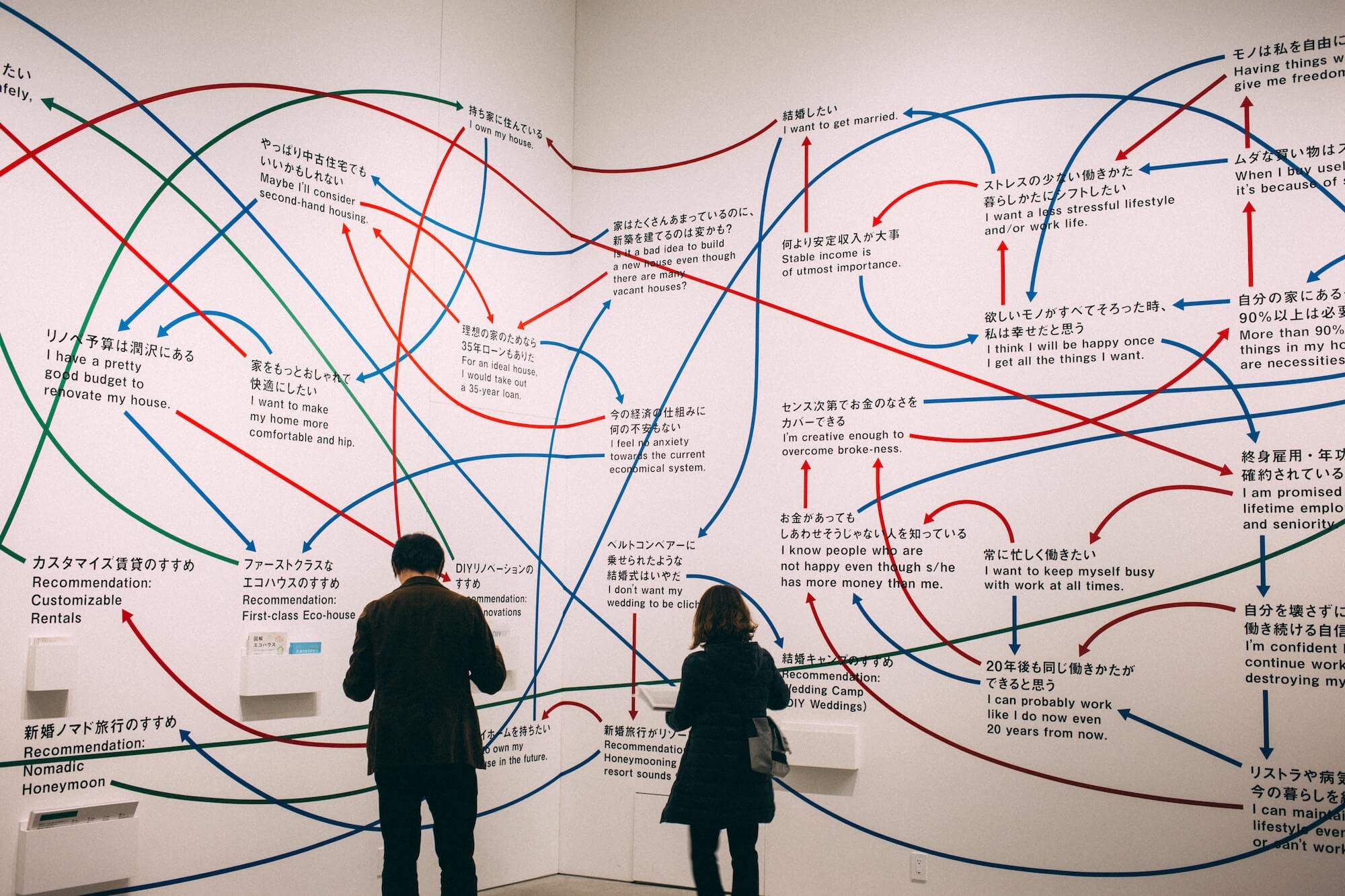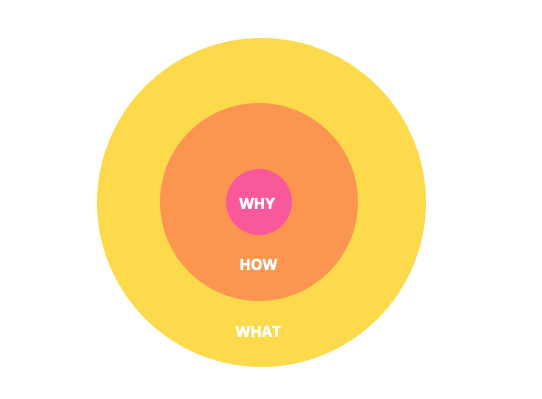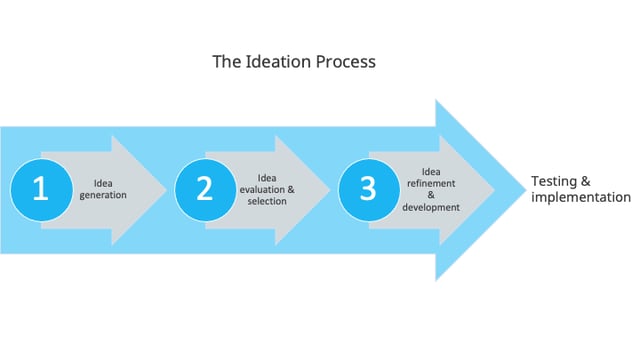5 Best Practices for Planning an Internal Ideation Process
We’ve all been at some point in one of those meetings where we’re asked to come up with out of the box ideas for new campaigns, products, or solutions to various issues. Sometimes we might feel under pressure, but even so, the approach can bring results, especially in smaller organizations.
However, these are usually quick fixes, and when it comes to staying ahead of the curve and be innovative, you need more than a brainstorming session.
While there’s nothing wrong with these methods, on the long term you can’t expect great results from ideation if you don’t have a plan to turn ideas into tangible innovations.
A well-planned process for generating, managing, and implementing ideas gives new opportunities that otherwise might have been missed. For this reason, in today’s article we'll be focusing on some of the challenges and best practices in planning an internal ideation process that will enable larger organizations to raise their game.

Table of contents
Why it’s important to plan your ideation process
Ideas are often seen as the cornerstone of innovation. However, a cornerstone is just one of the elements that brings a house together. To build it, you need more than that. So does innovation. Ideas are the easy part. They won’t miraculously turn into innovations on their own. You need to build and develop them systematically to succeed at innovation.
Regardless of the type of innovation you’re after, ideas need to be managed and developed to reach their full potential. Sporadic techniques, workshop or brainstorming sessions are not enough. If you want to bring the best ideas to life, a more elaborate plan is required.
But before moving ahead let’s remember what ideation is. Ideation is the creative process of generating, developing, and communicating ideas. Even though ideation has been known mostly in the context of design thinking, it is not just about generating or collecting ideas, but also about solving specific problems, or finding new methods to implement a solution.
Looking at these three steps involved in the ideation process, it’s easy to understand why planning the big picture is so important.
Having a systematic and purposeful ideation process that turns into a habit for the entire organization is not easy. But this should not be discouraging. With careful planning, and some good practices, ideation can be a steppingstone for innovation.
On the other hand, even though planning an ideation process can greatly increase your odds of success, focusing too much on planning and not enough on execution can lead to analysis paralysis. When planning the ideation approach for your organization, don’t lose sight of the purpose of ideation, which is not just generating more ideas, but also implementing them.
So, work towards a good balance between strategy and execution, considering the overarching goals of the organization.
Common Challenges in running an ideation process
The road to innovation is not smooth but it’s always good to try and anticipate what could come your way. For this, we’ve put together a list with the common challenges that tend to obstruct ideation processes, and along the way, we’ll also provide some tips on how to go about these.
-
The obsession with techniques and methods
Many of the challenges associated with ideation have their roots in the misconception that ideation is just about idea generation. So, naturally people tend to plan around techniques and methods meant to help with idea generation, like brainstorming sessions, idea generation workshops and all the various techniques that have been developed over time to help boost creativity.
Unfortunately, this approach disregards all the other phases of ideation, which are just as important. For example, for the first stage of generating ideas, brainstorming cards, or idea challenges are useful techniques. When it comes to idea evaluation and selection there are tools like the impact-effort matrix or the stage-gate process. And let’s not forget about refining and developing ideas where you can use storyboarding or analogy thinking.
There are numerous possibilities and so many methods you can choose from. Regardless of technique, consider visualizing your timeline and where to use what. This way, you simplify your planning by visually organizing all the elements you need to juggle with.
In our complete guide to ideation we described in more detail how to choose the right method or technique for each stage of ideation.
Since we discussed techniques and methods, the use of tools can also become a challenge in planning and doing ideation.
-
Finding the best tool for the job
This obsession for techniques and methods can also happen when looking for the perfect tool to do the job. However, when it comes to the right tools for ideation, the practicalities matter a bit more.
In short, to find the right tool you need to do your research and get back to the basic question: What do you want to achieve with it?
Synchronous tools like meetings and ideation workshops are great when a decision needs to be made and ideas bounced around a specific topic, in smaller groups.
The downside with these is that you cannot have too many people working together, nor different perspectives because the dynamic of such meetings tends to favour the loudest people in the room. What’s more, in large organizations people are often stretched thin in many directions and finding calendar time to get everyone on board becomes complicated.
Asynchronous tools like idea management software or similar ones enable collaboration and communication at each person’s convenience and are great at managing ideas and engaging as many people as you want.
On the other hand, even though in practice the tools are easy to use, they require a systematic approach where those in charge need to make the continuous and conscious effort of maximizing their potential.
Good tools will cater to your needs for most phases, but sometimes it makes sense to use a specific thing for a specific need. Using the good tools that can enhance your ideation work is challenging, but with some research, patience, and hard work you can see concrete benefits of this effort.
The best time to look for the right tool is today! We'd dare to say you should give Viima a try, since you can start using it in just a few minutes. For example, if you are planning to run a brainstorming session and you don't know where to start, we have a step by step guide on how to do that, as well as a dedicated board template where you can easily start collecting ideas.
-
Integrating existing processes
Every organization has its own processes, and when you can’t fight them, you have to join them. Otherwise, what would be the point to work in silos? With ideation you want to keep the wheels turning and support the development and improvement of all the other processes.
If we take the Pfizer example, we can learn from their digital transformation journey. After all, their preparation work contributed to the development and rollout of a new vaccine in record time. Their digital transformation journey started years before Covid-19 hit. The goal was to become more agile and innovative so they can adapt to the rapid changes in technology and prepare for the unexpected.
In a field were both clinical and regulatory processes are very complex, their preparation work to navigate such complicated environments contributed to a rapid response from scientists working together against the clock.
Luckily, not all organizations operate with such time-sensitive and life concerning issues, but the conclusion we can draw is that there will always be processes you need to adapt to, as well as new ones to develop along existing ones.
Best practices for planning an ideation process
Next, let’s have a look at some of the best practices when planning an ideation process in an organization.
But before that, what do we mean by planning an ideation process and what it entails?
Most organizations have a method of collecting and approving ideas. But not all have an organized, systematic process built for it. This means that they miss opportunities and leave potential on the table. Without frameworks and repeatable methodologies in place, people have a hard time being proactive and instead spend time putting out fires and working on sub-optimal matters.
As mentioned, one of the challenges with planning an ideation process, is to align it with the specifics of the organization, the goals, strategy, and internal processes already in place. In short, what existing capabilities you can leverage and what still needs to be built in a way that the ideation process is scalable and easy to be replicated?

Planning to ideate, can be similar to planning any other continuous process. You document the scope and objectives of the ideation processes you want to put in place. What should the process look like, what are the expected deliverables, required resources, milestones, teams, and approval processes for ideas to be executed? Bring everything together in a format that can be communicated to stakeholders.
Of course, this is a lengthier planning process, and some phases will be skipped when dealing with ad-hoc needs. But even if you can’t afford to put a lot of time and planning in the ideation process, it’s always best to focus on strategic matters that become habits.
Now, let’s have a look at some of the best practices.
1. Decide on the right process
As mentioned earlier, to successfully plan an ideation process, we need to look at it holistically, not simply as the third stage of design thinking. For this, we should first see how ideas are managed in an organization.
Companies usually use one of the following idea management processes:
- Centralized: ideas are collected from employees in a transparent manner. A strategic group has a decisive vote on what happens to the ideas, which ones are implemented and how.
- Decentralized: in this process ideas are managed by each group separately, without a strategic decision group that has to give the green light.
- Hybrid: a combination of the two mentioned above.
For a more in-depth analysis of how these processes work in practice, download the Ultimate Guide to Idea Management Processes.
Regardless of the process in place, it’s essential to communicate to the entire organization the goal of the chosen process, how it works in practice, how will everyone contribute and what’s in it for them. But more on the roles and contributors, later in the article.
2. Create collaborative processes
You’ve decided on some processes and how ideas will be managed but how will everything tie together in practice?
Idea challenges are a popular method of getting new ideas, solutions to problems and simply engage employees in the everyday operations of the organizations. But it might be that this approach is not taking full advantage of the diverse knowledge of all employees.
Idea challenges based solely on rewards could sometimes focus too much on competition, and not enough on collaboration.
Idea challenges based solely on rewards could sometimes focus too much on competition, and not enough on collaboration. If the processes are not created to enable collaboration, employees won’t have the chance to work together and build on top of each other’s knowledge.
After all, innovation is also about collaboration. The best products and services are the result of various creative minds coming together, building on each other’s background, and knowledge and connecting the dots to add more layers to the original idea.
To get people in the collaboration spirit it’s important to always communicate the why behind your plan. The “Why” is at the core of good communication, the glue that brings people together. Explaining why you are doing what you are doing and why they should care, takes into account their intrinsic motivations as well. 
For example, Renault is encouraging employees to be part of the whole ideation process by giving them the opportunity to actually develop and implement the selected ideas.
In large organizations it’s easy to get disconnected from the goals and vision of the company. So, when planning an ideation program consider that building a community inspires employees and contributes to the success of the ideation process.
In Renault’s case, employees showed more enthusiasm when other colleagues volunteered to develop the ideas. For example, they were able to work a couple of days a week to conduct market research or develop a prototype. As a result, the commitment rate increased by 29%.
An idea is as good as the people working for it. Simon Sinek, author of “Start With Why” once said “a good idea is often destroyed by bad people and good people can always make a bad idea better”.
So, bringing together committed and motivated people will benefit the ideas’ lifecycle. But this is not enough. The key to build a community spirit and encourage communication that brings people together is transparency. Which takes us to the next best practice on the list.
3. Plan for transparent ideation processes
Ideation is also a creative process so you never know where the best ideas will come from. That’s where one-time brainstorming sessions or ideation workshops usually fall short. Naturally, some people will feel more confident to speak up than others who are more introverted and whose ideas and creativity could be hindered in such environments.
By creating an ecosystem that facilitates free and open sharing of ideas in a safe space, you enable as many people as possible to get involved.
Working together with colleagues makes things more enjoyable but remember that if the organization portrays innovation as simply all fun and games, then you might be dealing with innovation theatre.
Innovation is not always comfortable and definitely not always fun. Not all ideas are worth the effort and honest discourse and rigorous debate are necessary to question assumptions. If everyone agrees on everything at all times, you might be going in the wrong direction.
Innovation is not always comfortable and definitely not always fun. Not all ideas are worth the effort and honest discourse and rigorous debate are necessary to question assumptions.
In this case, creative abrasion, a process, or better said, an intellectual friction where ideas are challenged in a productive way, plays an important role.
Different points of view need to be amplified while leveraging the organization’s diversity. And this is possible in a transparent ideation process that encourages everyone to be part of the program, but where there’s simultaneously a culture and atmosphere that are psychologically safe.
Since we mentioned creative abrasion, we should next direct our attention to another important aspect: roles and leadership.

4. Clearly defined roles and strong leadership
As mentioned, collaboration is fuelling innovative ideas, and transparency enables better collaboration and communication. However, collaboration can also lead to tensions that can affect the community spirit.
That’s where truly great leaders shine. They don’t overshadow employees. Instead, they remind them of their purpose, facilitate better communication and trust people’s creativity and ability to be innovative in their role.
In fact, creative abrasion is something good leaders know how to nurture. Creative abrasion is about leveraging differences in opinion and use them to one’s advantage. Leaders that succeed at this can manage tensions and nurture environments where people are encouraged to share their thoughts, while allowing confrontations where ideas are challenged and improved.
Creative abrasion is about leveraging differences in opinion and use them to one’s advantage.
To explain this a bit better let’s take the example of Google, an organization famous for its ability to innovate and scale innovations. Bill Caughran, former VP of engineering lead teams to innovate by setting a vision that motivated employees and by creating a community capable of generating and executing new ideas.
When Google was looking to meet their increasing storage needs, two self-organizing teams were formed. The two teams had very different views and ideas of how to solve the problem. One team wanted to adapt and improve the existing method, while the other wanted to build a completely new solution.
Caughran facilitated communication and decision-making as to avoid chaos, but he didn’t interfere with the ideas that were put forward. In doing that he didn’t set the direction or told people what to do. Instead, he created the context that allowed ideas to flourish and new opportunities to emerge.
For the short term, and a more viable solution, they used ideas that built on top of the existing storage system, but for the long term they worked with ideas developed by the team assigned to build the next-generation system.
You’ve ticked some of the boxes. You have the transparent environment that enables collaboration and processes that will guide the well-functioning of the program. As ideas move forward and decisions need to be made, how can you ensure a low failure rate?
5. Make better decisions by implementing an idea evaluation process
Choosing which ideas to pursue, and which to leave for later can make or break your innovation efforts. Idea evaluation is challenging for most managers and leaders.
When it comes to important decisions that involve novel ideas, like new products, or changes that can have a big impact, evaluating these ideas can turn into a bottleneck. Large organizations typically require detailed business calculations and projections before making major decisions. Innovation involves a lot of uncertainty and trying to predict everything down to the smallest detail can kill many great ideas prematurely – or lead you to pursue safer, but at best mediocre, ideas.
Innovation involves a lot of uncertainty and trying to predict everything down to the smallest detail can kill many great ideas prematurely.
On the other hand, basing decisions simply on an idea’s popularity is not ideal either. The answer lies somewhere in the middle. There are many types of ideas, and each should be evaluated accordingly. For example, ideas on incremental improvements are very different than radical ones on new products, thus the criteria by which they should be evaluated are also very different.
Planning an ideation process should consider these aspects by communicating clear metrics that reflect the various dimensions of an idea. Even so, there is no certainty that you will always make the best decisions. The evaluation process you put in place is a steppingstone that needs alteration and iteration. In the end, there’s no way to go around testing these ideas in real life, with customers or users.
The lean methods can help facilitate a streamlined decision-making process as they call for testing ideas while using real time quantitative and qualitative data to help you decide on the next steps. The riskiest or craziest ideas are those often ignored so when testing your assumptions, these should be first on the list. This provides more clarity and guides you to align on other decisions as well.
That being said, evaluating ideas is a constant effort that needs to be well planned and organized. Having the right tool for the job goes a long way. A good tool can help you keep organized and it automates many manual tasks. It also helps in visually communicating to all team members and making data accessible.
We went into the details of choosing a tool that helps you evaluate ideas and how it works in practice. You can read more about it here.
Even so, it’s good to note that decision-making is not just about choosing the best ideas and minimizing risks. Decision-making is an art that leaders are constantly striving to get better at.
Conclusions
If we go into the nitty gritty of planning an ideation process, there are many things to keep in mind, and pay attention to, but if we take a step back and look at some basic principles, we gain a clearer perspective.
First, remember to always tie the goals of ideation to the strategic organizational goals, and keep in mind that “a goal without a plan is just a wish”. So, a plan will help you move forward and closer to those goals.
Second, the ultimate goal of ideation is to push your innovation efforts forward. For this, you need a holistic approach that brings together an innovation strategy, idea management processes and stellar leaders to hone the collective knowledge and creativity within the organization.
Last, but not least, an ecosystem built for innovation is highly complex and requires good organization and structure. Luckily, there are tools that even though won’t do the work for you, will make your job easier.
Start planning your ideation process with the right tool. See how Viima can support your needs, every step of the way, from idea generation to implementation. Book a demo!











